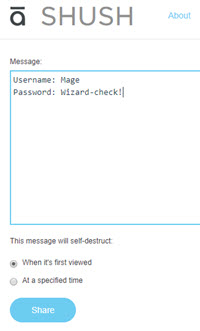No doubt, the most secure way to give someone a password or other confidential information is in person or over a private phone call. There are times, however, when you want to send a password or a bank account number via email simply because of the convenience. This article explores how to send secure information safely.
Most people find email encryption software to be expensive and complicated to work with. Ephemeral messaging may be the answer. When something is ephemeral, it is considered “temporary” or “only lasting a short time.” A great early example of ephemeral messaging is from the James Bond movies. James Bond would often receive a tape about his secret mission. Upon hearing the message, the final thing it would warn 007 is that the message will self-destruct.
SnapChat is a very commonly used application that is a modern example of ephemeral messaging. SnapChat lets users of its phone application send pictures or text that disappear either after a short time or after being viewed. While it’s popular among teenagers and some adults, it’s not practical for business use.
The solution I recommend for business is called Shush. It’s an online service provided free by Articulate, makers of e-learning course authoring tools. You can try Shush out for yourself at this link: https://shush.articulate.com/. You will be pleasantly surprised to find that the service is completely anonymous and does not require a login for either the sender or receiver!
You go to the site and enter (or copy/paste) the information you want to encrypt into the presented window:

After you enter the content, you then choose how long you want the message to live. You obtain the link by clicking the share button. Click the Copy button and paste the link into an email message to send to your contact. Once the duration expires, the link will no longer work, and your message can no longer be retrieved.
Depending on the duration you set, the message will be viewable to anyone that has the link. The default and most secure solution is “When it’s first viewed.” Upon the first view is an excellent choice for messages that you know will be read promptly as they only last for a maximum of 12 hours. Messages sent this way can only be viewed one time, and then they are gone forever. Messages that are set for a specific duration such as a day or a week can be seen again and again by anyone with the link.
Thank you for reading. This blog post will now self-destruct!
